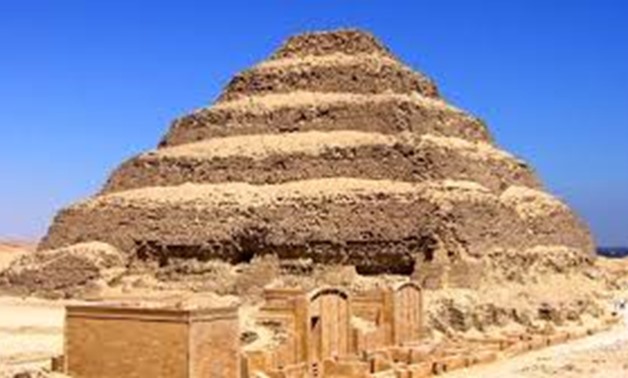
File - Djoser Pyramid.
CAIRO - 22 April 2020: Egypt's Ministry of Tourism and Antiquities is to launch a new virtual tour for the Step Pyramid Complex of Djoser on April 22 at 8 pm.
The tour will be posted on the ministry’s official website and social media platforms.
Third Dynasty Step Pyramid complex of King Djoser (c.2667–2648 BC), is Egypt’s oldest pyramid. It is also considered the first largescale stone construction in history, and an important phase in the evolution of the royal tomb towards a true pyramid shape.
The complex is surrounded by a 1,645meter long external stone wall ten meters high. It includes ten architectural elements: the entry courtyard, the entrance colonnade composed of forty columns in two rows, the South Court, the 60meter high Step Pyramid, the South Tomb, the Sed Festival court and its chapels, the Pavilion of the South and the Pavilion of the North, and the Northern Temple.
The South Court and the Sed Festival court, with its chapels, acted as the setting in which the king could celebrate this important royal ceremony that aimed at rejuvenating the king and regenerating his power.
The Step Pyramid was not built all at once, but in stages. A square mastaba around 8.5 meters in height was first built, which was later enlarged.
Another 9 meters were added on the east side so as to link the building to eleven shafts belonging to Djoser’s family.
Four mastabas built on top of one another were built on the expanded mastaba, thus giving the structure its height of 60 meters as well as its pyramidal form. The base of the pyramid is around 121 x 109 meters.
The burial chamber lies at the bottom of a shaft in the center of the pyramid at a depth of 28 meters.
Construction of the pyramid was overseen by the brilliant architect Imhotep, who held titles such as “advisor to the King of Lower Egypt”, the “first after the King of Upper Egypt”, “the administrator of the Great Palace”, and the “greatest of seers of Heliopolis” (the title held by the highpriest of the sun god Ra).
Imhotep was deified in ancient Egypt, and was a patron of scribes. The Greeks identified him with Asclepius, the god of medicine.
The complex was initially excavated from 1924 to 1935. The French architect JeanPhilippe Lauer—working for Egyptian authorities— dedicated most of his life to the systematic protection and conservation of the Step Pyramid complex for around 70 years starting 1926.

Comments
Leave a Comment